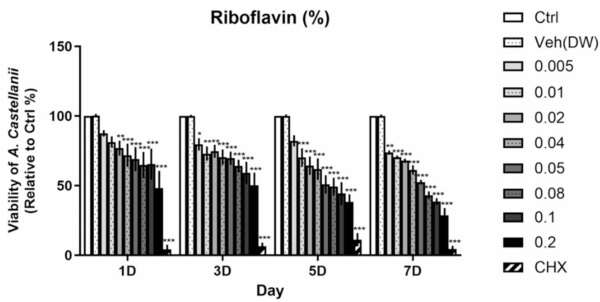Uncategorized
Strathclyde minor groove binders (S-MGBs) with activity against Acanthamoeba castellanii
July 16, 2025
Two Faces of Danger: Trophozoites vs. Cysts
Acanthamoeba exists in two forms:
- Trophozoites: Active, feeding cells that invade tissues.
- Cysts: Dormant, armored structures resistant to disinfectants and immune attacks .
Encystation, triggered by stress like drug exposure, allows the amoeba to survive harsh conditions for years. This dual lifecycle complicates treatment, as drugs must target both forms .
Drug Resistance: A Growing Crisis
Studies reveal alarming resistance to first-line treatments like chlorhexidine and polyhexamethylene biguanide (PHMB). For example, while PHMB kills 99% of trophozoites at 0.02%, cysts require 10× higher concentrations . Even worse, some strains evolve efflux pumps that expel drugs, rendering therapies ineffective .
Current Treatments: Strengths and Limitations
Biguanides: The Gold Standard
- PHMB and chlorhexidine disrupt cell membranes but struggle against cysts.
- Octenidine hydrochloride (a newer biguanide) shows superior cysticidal activity, achieving 90% eradication at 0.1% concentration .
Antifungals and Repurposed Drugs
- Azoles (e.g., voriconazole) inhibit sterol biosynthesis by targeting the CYP51 enzyme. Synergy with statins (e.g., pitavastatin) enhances trophozoite death .
- Terconazole, an antifungal, demonstrated 80% amoebicidal activity in preclinical trials .
Table 1: Efficacy of Common Anti-Acanthamoeba Agents
| Drug Class | Example | Trophozoite IC₅₀ | Cyst Eradication | Limitations |
|---|---|---|---|---|
| Biguanides | PHMB | 0.02% | 0.2% | Cyst resistance |
| Azoles | Voriconazole | 2.5 µg/mL | Ineffective | CYP51 variability |
| Plant Compounds | Turmeric extract | 100 µg/mL | 500 µg/mL | Dose-dependent toxicity |
New Frontiers: Promising Therapies in Development
Riboflavin + UV Light: A Photodynamic Surprise
Riboflavin (vitamin B₂), when activated by UV light, generates reactive oxygen species that obliterate Acanthamoeba. At 0.01% concentration, riboflavin alone reduces trophozoite viability by 70% in 3 days, while UV combination therapy achieves 95% kill rates .

Table 2: Riboflavin’s Dose-Dependent Toxicity
| Concentration | Day 1 Viability | Day 3 Viability | Day 7 Viability |
|---|---|---|---|
| 0.005% | 98% | 95% | 90% |
| 0.01% | 85% | 30% | 10% |
| 0.2% | 45% | 20% | <5% |
Nature’s Pharmacy: Plant-Based Metabolites
- Turmeric extracts disrupt amoebic membranes, achieving 80% trophozoite death at 100 µg/mL. Higher doses (500 µg/mL) also target cysts .
- Garlic-derived allicin forces trophozoites into premature encystation, followed by cyst rupture at 1000 µg/mL .
Synthetic Innovations: Isobenzofuranones and PHMB Analogs
- Isobenzofuran-1(3H)-ones (QOET-3 and QOET-9) show IC₅₀ values of 1.2 µg/mL against trophozoites, outperforming PHMB .
- PHMG (polyhexamethylene guanidine) matches PHMB’s efficacy against cysts but with lower toxicity to human cells .
Targeting Weaknesses: Disrupting Metabolism and Stress Responses
Starving the Amoeba: Sterol Biosynthesis Inhibitors
CYP51, a key enzyme in ergosterol production, is a prime target. Azoles like isavuconazole block CYP51, depleting sterols and causing membrane collapse. However, Acanthamoeba’s CYP51 structure varies, requiring tailored inhibitors .
Alternative Oxidase (AOX): A Backup Energy Pathway
When mitochondrial respiration is blocked, Acanthamoeba switches to AOX for energy. Inhibiting AOX with purine analogs like ATP enhances drug susceptibility .
Conclusion: The Road Ahead
While Acanthamoeba castellanii remains a formidable foe, recent breakthroughs offer hope. Combining cyst-penetrating agents (e.g., octenidine) with metabolism-disrupting drugs (e.g., isobenzofuranones) could deliver a one-two punch. Meanwhile, plant-derived compounds and photodynamic therapies provide safer, scalable alternatives. Collaborative research, supported by advanced assays like CTC staining for rapid drug screening , will be critical to overcoming resistance and saving sight—and lives.
